|
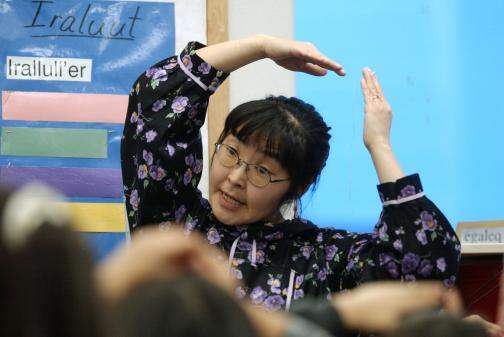 NAPASKIAK
-- The first-grade classroom at Z. John Williams School could be anywhere
in America. Pint-size wooden chairs and knee-high tables, plastic bins
of crayons, walls plastered with colorful posters and strings of alphabet
letters. NAPASKIAK
-- The first-grade classroom at Z. John Williams School could be anywhere
in America. Pint-size wooden chairs and knee-high tables, plastic bins
of crayons, walls plastered with colorful posters and strings of alphabet
letters.
But
in Christine Samuelson's room, the alphabet is only 18 letters long and
A doesn't stand for apple. A is for angqaq, C means cauyaq and E is for
ena.
Samuelson
teaches in Yup'ik, the mother tongue of the Eskimos who have inhabited
the Yukon-Kuskokwim Delta for thousands of years.
While
indigenous languages everywhere edge toward extinction, the Y-K Delta
remains a stronghold of Native language, and culture and schools like
Z. John Williams are one reason why. Parents who raise their children
speaking Yup'ik have demanded Yup'ik instruction in their schools. The
local district has provided it.
But
that support may be faltering. Standardized state and federal student
achievement tests have raised the stakes for students to master English
ever earlier. Some residents argue that Yup'ik instruction belongs in
the home, leaving schools to prepare students for jobs in an English-based
economy. And television has become an ever present language instructor
in most homes, flooding the tundra with the words and phrases of American
pop culture.
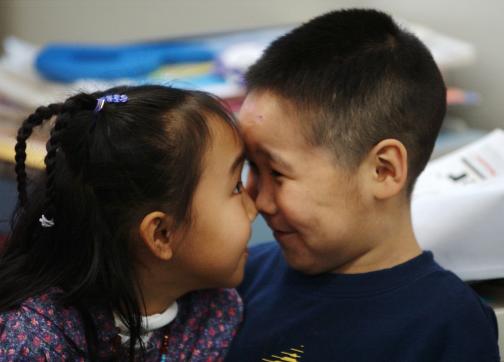 For
centuries, the language of the Delta passed naturally from one generation
to the next. But increasingly, Delta parents are grappling with how, where
and even why their children should learn Yup'ik. Their answers may determine
whether the language of their forebears withers or thrives. For
centuries, the language of the Delta passed naturally from one generation
to the next. But increasingly, Delta parents are grappling with how, where
and even why their children should learn Yup'ik. Their answers may determine
whether the language of their forebears withers or thrives.
ENGLISH
ONLY POLICY
Woven
baskets in display cases and a handmade kayak hanging from the ceiling
reinforce the feeling that Z. John Williams School is well-rooted in its
region. Drawings of local fish and wild animals line the hall, with detailed
descriptions of themwritten below the pictures.
But
even this academic exercise shows the inexorable mix of languages on the
Delta. "Naterrnat pingayunek vitamin aangqertut ukuuluteng-llu vitamin
A, D," reads one caption below a drawing of a halibut.
Bilingual
education in Alaska goes back nearly 200 years. The first formal schools,
established by Russian Orthodox, Jesuit and Moravian missionaries, encouraged
Yup'ik and other Alaska Native languages even as they introduced
English. Missionaries helped produce the first written alphabets, dictionaries
and translations in Yup'ik, which they used to translate the Bible
and other works.
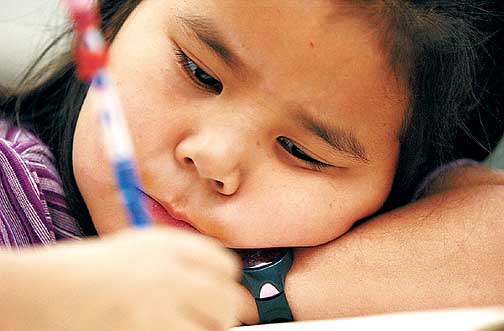 By
the late 1800s, however, a different theory of language instruction swept
through Alaska that proved deadly to Native tongues. To assimilate Native
Americans into mainstream America, Alaska educators demanded that students
stop speaking their parents' language. Children who didn't were
humiliated, threatened and beaten. By
the late 1800s, however, a different theory of language instruction swept
through Alaska that proved deadly to Native tongues. To assimilate Native
Americans into mainstream America, Alaska educators demanded that students
stop speaking their parents' language. Children who didn't were
humiliated, threatened and beaten.
The
English-only policy of the U.S. Bureau of Education and the Bureau of
Indian Affairs was, wrote University of Alaska Fairbanks linguist Michael
Krauss, "cultural genocide in the classroom." Its effect still
lingers in rural Alaska. In many communities, only the elders still speak
their ancestors' language. By 2050, more than two dozen Alaska Native
languages will have disappeared, Krauss predicts.
Yup'ik
is an exception. The geographical isolation of lower Yukon and Kuskokwim
villages kept English at bay longer than in other regions, according to
Krauss. Starting as early as 1970, parents and schools there embraced
bilingual education.
Rachel
Nicholai is a product of that system. She grew up speaking Yup'ik
at home, like her parents and grandparents, but she learned English in
school. She went on to college and now teaches 12th grade in Napaskiak,
a village of 400 people on the Kuskokwim River a few miles downriver from
Bethel.
 Nicholai
wants her daughter to carry on the family's Yup'ik tradition. Nicholai
wants her daughter to carry on the family's Yup'ik tradition.
"I
want her to continue the language and not let it diminish," she said
recently.
In
Napaskiak, that means her daughter's first four years of school will
be taught in Yup'ik.
SCHOOL
IN CRISIS
The
Lower Kuskokwim School District offers communities a choice of which language
— English or Yup'ik — their children will study in kindergarten
through third grade. Of the district's 21 village schools, 18 have
chosen the latter.
In
Napaskiak, Kwethluk and other villages, Yup'ik-speaking students
learn to read and write, add and subtract in their Native tongue. Though
many children know some English, picking it up from their parents, peers
or the ubiquitous satellite TV, English instruction in kindergarten is
limited to 15 minutes a day. It ramps up rapidly, however, and by fourth
grade, classes at every school in the district are taught solely in English.
Not
surprisingly, said Napaskiak principal Gloria Ingle, many of her students
don't perform well on their third-grade state benchmark tests, which
are in English.
"It's
like teaching you English to third grade and then giving you a test in
French," she said.
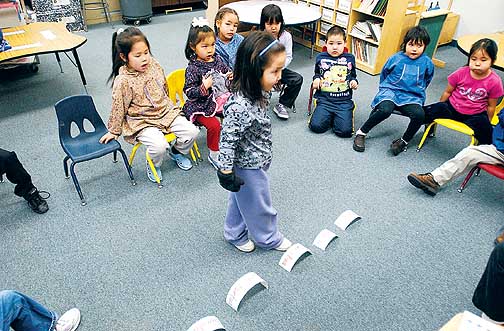 Napaskiak
students have done well in Yup'ik, winning a statewide bilingual
essay contest three years in a row and the district's Battle of the
Books. And their test scores rise steadily with time, Ingle said. Four
of Napaskiak's five seniors last year passed the new high school
exit exam. Napaskiak
students have done well in Yup'ik, winning a statewide bilingual
essay contest three years in a row and the district's Battle of the
Books. And their test scores rise steadily with time, Ingle said. Four
of Napaskiak's five seniors last year passed the new high school
exit exam.
The
district has asked to translate the third-grade tests into Yup'ik,
which could boost students' first benchmark scores. State and federal
officials are thinking about it.
But
because scores haven't improved under the new federal No Child Left
Behind Act, Napaskiak has been designated a school in crisis. If scores
don't rise, sanctions will be imposed that can include implementing
a new curriculum or replacing the staff.
Ingle
argues the scores don't adequately reflect reality on the Delta.
"If
you look at the progression (of student improvement over time), that's
exactly what a school is supposed to do," she said. "So when
they say I'm in crisis, I really can't believe it."
Nicholai
said she isn't concerned about her daughter's third-grade test
scores.
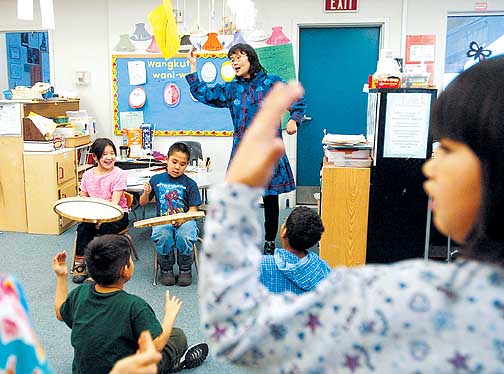 "This
first benchmark doesn't matter to me, because she is just coming
from Yup'ik-language instruction. I know she's going to make
it through the next two," she said. "This
first benchmark doesn't matter to me, because she is just coming
from Yup'ik-language instruction. I know she's going to make
it through the next two," she said.
Another
Napaskiak parent, James Joekay, said the village's decision to teach
the primary years of school in Yup'ik was less an academic issue
than a cultural choice. They had seen English become their children's
predominant language, with television replacing everyday Yup'ik conversation
as the main source of vocabulary and ideas, he said.
"To
me it's really important" to reinforce Yup'ik in school,
Joekay said. "We don't want to lose our Yup'ik language."
Test
scores may be low, he said, but there's a trade-off. The language
is coming back, he said.
"You
can hear the difference in the village," he said. "My kids talk
to my parents, their grandparents in Yup'ik. It makes the grandparents
happy."
'THINGS
ARE VERY, VERY CRITICAL'
Languages
become extinct when people stop speaking them, and most of Alaska's
20 indigenous tongues will vanish by the end of this century, according
to experts at the Alaska Native Language Center at the University of Alaska
Fairbanks.
"It's
very depressing," center director Lawrence Kaplan said. "People
are really trying to maintain some of the languages and revive others,
but things are very, very critical. We're hoping that the efforts
that are under way will have some effect on reversing the decline."
Yup'ik
is less endangered than most Alaska languages because it is still passed
on in the traditional way — by parents speaking to their children.
In villages on the Delta, Yup'ik remains the language of subsistence
and the natural world, of hunting and fishing and family relationships.
The language developed over thousands of years and reflects the Delta's
unique environment in a way that English cannot, Yup'ik speakers
say.
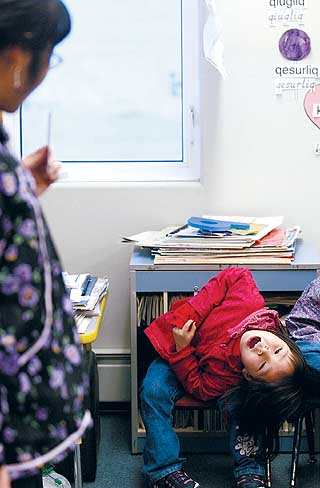 Teaching
it in school alone won't keep Yup'ik alive, but it will help
reinforce it, Kaplan said. To thrive, a language must be spoken at home.
It must be functional, serve some purpose. Teaching
it in school alone won't keep Yup'ik alive, but it will help
reinforce it, Kaplan said. To thrive, a language must be spoken at home.
It must be functional, serve some purpose.
But
bilingual education like the Yup'ik program on the Delta has side
benefits, he added.
"Most
linguists believe the most effective education is delivered in somebody's
first language," Kaplan said, "that the best way to start a
kid in school is to teach them in what they know rather than what they
don't know."
Lower
Kuskokwim School District Superintendent Bill Ferguson, who taught in
the nearby village of Kasigluk for 30 years and has been superintendent
in Bethel for six years, sighs when the subject of bilingual education
comes up. It's been debated in the region for decades, he said.
"You
can find research to support either argument, that Yup'ik or English
makes for better students," he said.
Ferguson
is among the people who believe it makes sense to start Yup'ik-speaking
students in a Yup'ik classroom. When children are comfortable at
school, he said, "the chances of being more focused on learning are
better."
But
a number of villages in his district want their children to study English,
not Yup'ik. Leading the charge is School Board member Lucy Crow.
ENGLISH
CALLED ESSENTIAL
A
commanding woman who owns a gift shop near Bethel's airport, Crow
didn't learn English until she was 12, when her family moved from
the tiny village of Nunapitchuk to Kasigluk, which had a Bureau of Indian
Affairs school. Even now, at 61, she said, "I'm having a helluva
time." It takes three or four readings to comprehend her School Board
meeting packets, she said. "I don't want the kids to go through
what I'm going through."
Crow
wants Yup'ik to survive, she said, but it doesn't belong in
school.
"English
is the basic tool to earn money. Some people say our (Native) people should
take over the jobs" available in the Bush, such as pilots, teachers,
principals and nurses. "But they can't take over the jobs without
going to college," for which English, not Yup'ik, is essential,
Crow said.
She
scoffs at the idea that parents don't have time to teach their children
Yup'ik at home.
"If
you believe in your language, turn off the TV, put away the Nintendo,
talk to your kids in your Native tongue. That's the only way it's
going to stay alive," she said.
Though
Crow is in the minority on the Lower Kuskokwim School Board, some Delta
parents believe she's right. The coastal village of Nightmute had
been among the villages where primary classes were taught in Yup'ik.
Several years ago parents voted to switch to English.
"A
majority of people in Nightmute speak Yup'ik at home, with their
kids," said Sandra Tulik, an aide at the school and lifelong resident.
"They figured that since they're speaking Yup'ik at home,
they wanted to start earlier in English."
Nightmute
School still provides an hour a day of Yup'ik instruction for every
student from kindergarten through 12th grade. It improves their oral and
written skills in their native tongue, principal Kathleen Bohach said.
Though
she arrived in Nightmute after the village adopted the English primary-grade
curriculum, Bohach said she understands parents' choice.
"Our
feet are being held to the fire" by high-stakes standardized tests
and the mandates of the No Child Left Behind Act, she said. Nobody wants
his or her school taken over by the state.
Most
Delta villages, however, have chosen Yup'ik for their primary-school
students. The Delta has a long history of fighting to keep Yup'ik
tradition and sovereignty alive, and for many residents the Native language
instruction is an act of political expression and cultural renewal.
Others
see more practical reasons for teaching Yup'ik in school and leaving
English for home study. Nicholai, the teacher who grew up in Napaskiak,
agrees that times are changing and that a cash economy is supplanting
the Delta's traditional hunting and gathering lifestyle.
Precisely
because she and her husband work regular jobs, she said, "I don't
have time at home to teach the alphabet, the phonics, in Yup'ik."
It makes more sense to practice English at home, Nicholai said, because
English-language workbooks and learning materials are readily available.
'ENGLISH
ISN'T THE ONLY ISSUE'
Determining
how best to serve Yup'ik-speaking students would be easy if there
were a direct link between test scores and first-language programs. But
there's not, said Bev Williams, the Lower Kuskokwim district's
director of academic programs. Benchmark test scores last year showed
no improvement at 17 of the district's 27 schools, some of which
teach in Yup'ik in the primary years and some where English is the
first language.
Test
scores rise and fall for a variety of reasons, Williams said. "English
isn't the only issue."
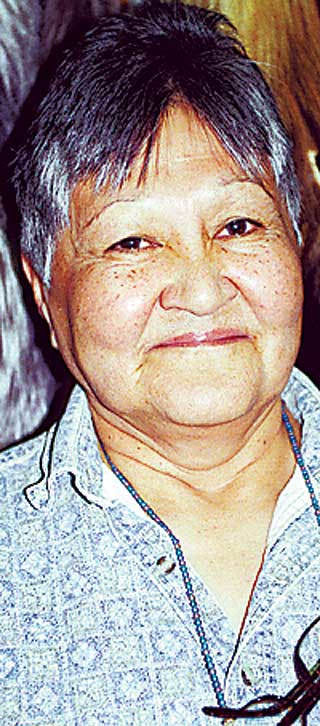 Whether
the school is in Kwethluk, Ketchikan or Kenai, attendance is a major factor
in student success, Williams said, and parental involvement in a child's
education is crucial. Staff turnover, which is a chronic problem at some
rural schools, can affect academic progress, as can overcrowding, dilapidated
facilities and a stable home life. Rural Alaska schools have their share
of problems, Williams said, but, she added, "the schools can't
be answerable for dealing with all the social problems and the educational
problems." Whether
the school is in Kwethluk, Ketchikan or Kenai, attendance is a major factor
in student success, Williams said, and parental involvement in a child's
education is crucial. Staff turnover, which is a chronic problem at some
rural schools, can affect academic progress, as can overcrowding, dilapidated
facilities and a stable home life. Rural Alaska schools have their share
of problems, Williams said, but, she added, "the schools can't
be answerable for dealing with all the social problems and the educational
problems."
While
student success varies widely throughout the Delta, one constant remains,
said Ferguson, the superintendent.
"Parents'
number-one priority is fluency in both languages so they can be a success
in both worlds," he said. Parents in Bethel embraced that view when
they lobbied the district for another language program. At Ayaprun Immersion
School, English-speaking students study in Yup'ik-only classes.
It's
challenging for the students, who come to school speaking little or no
Yup'ik, said co-principal Agatha John-Shield. "Our (Yup'ik)
parents say that even if you don't understand (the words), eventually
you'll get it."
John-Shield,
who grew up in Toksook Bay and married a black man , said Bethel parents
wanted a school to provide what many homes could not: Yup'ik instruction.
The city of nearly 6,000 people is the melting pot of the Yukon-Kuskokwim
Delta. Almost 70 percent of the population is all or part Alaska Native,
with the remainder a mix of Euro-, Asian- and African-American. Ayaprun
reflects Bethel's diversity and its Yup'ik roots, she said.
"Some
of our parents don't speak the language because their parents were
punished for speaking it" in school years ago, she said. "So
we're going back, giving (Yup'ik) back to the parents through
the school."
It
hasn't been easy, John-Shield added. "One of our parents said
recently that if we were some type of species, the federal government
would be trying to keep us alive. Our language is endangered," she
said.
Some
people in Bethel believe Ayaprun is trying to teach "the old ways,"
John-Shield said, "that a kayak is better than a skiff and outboard.
We're not trying to go way back. We're just integrating the
two, to make a balance between both worlds."
But
achieving that balance is becoming more difficult yet increasingly important,
Ferguson said. When he arrived on the Delta 35 years ago, parents and
grandparents speaking in Yup'ik were the source of information and
entertainment. Now television and the Internet fill young minds with stories
and words.
"Most
kids don't hear Yup'ik at home," Ferguson said. "Until
that changes, Yup'ik culture will be a dying culture. It has to come
from the home. School systems can help sustain it. But we can't keep
it alive without their help."
Reporter
Joel Gay can be reached at 257-4310 or jgay@adn.com.
|


![]()
 NAPASKIAK
-- The first-grade classroom at Z. John Williams School could be anywhere
in America. Pint-size wooden chairs and knee-high tables, plastic bins
of crayons, walls plastered with colorful posters and strings of alphabet
letters.
NAPASKIAK
-- The first-grade classroom at Z. John Williams School could be anywhere
in America. Pint-size wooden chairs and knee-high tables, plastic bins
of crayons, walls plastered with colorful posters and strings of alphabet
letters. For
centuries, the language of the Delta passed naturally from one generation
to the next. But increasingly, Delta parents are grappling with how, where
and even why their children should learn Yup'ik. Their answers may determine
whether the language of their forebears withers or thrives.
For
centuries, the language of the Delta passed naturally from one generation
to the next. But increasingly, Delta parents are grappling with how, where
and even why their children should learn Yup'ik. Their answers may determine
whether the language of their forebears withers or thrives. By
the late 1800s, however, a different theory of language instruction swept
through Alaska that proved deadly to Native tongues. To assimilate Native
Americans into mainstream America, Alaska educators demanded that students
stop speaking their parents' language. Children who didn't were
humiliated, threatened and beaten.
By
the late 1800s, however, a different theory of language instruction swept
through Alaska that proved deadly to Native tongues. To assimilate Native
Americans into mainstream America, Alaska educators demanded that students
stop speaking their parents' language. Children who didn't were
humiliated, threatened and beaten.  Nicholai
wants her daughter to carry on the family's Yup'ik tradition.
Nicholai
wants her daughter to carry on the family's Yup'ik tradition.
 Napaskiak
students have done well in Yup'ik, winning a statewide bilingual
essay contest three years in a row and the district's Battle of the
Books. And their test scores rise steadily with time, Ingle said. Four
of Napaskiak's five seniors last year passed the new high school
exit exam.
Napaskiak
students have done well in Yup'ik, winning a statewide bilingual
essay contest three years in a row and the district's Battle of the
Books. And their test scores rise steadily with time, Ingle said. Four
of Napaskiak's five seniors last year passed the new high school
exit exam. "This
first benchmark doesn't matter to me, because she is just coming
from Yup'ik-language instruction. I know she's going to make
it through the next two," she said.
"This
first benchmark doesn't matter to me, because she is just coming
from Yup'ik-language instruction. I know she's going to make
it through the next two," she said. Teaching
it in school alone won't keep Yup'ik alive, but it will help
reinforce it, Kaplan said. To thrive, a language must be spoken at home.
It must be functional, serve some purpose.
Teaching
it in school alone won't keep Yup'ik alive, but it will help
reinforce it, Kaplan said. To thrive, a language must be spoken at home.
It must be functional, serve some purpose. Whether
the school is in Kwethluk, Ketchikan or Kenai, attendance is a major factor
in student success, Williams said, and parental involvement in a child's
education is crucial. Staff turnover, which is a chronic problem at some
rural schools, can affect academic progress, as can overcrowding, dilapidated
facilities and a stable home life. Rural Alaska schools have their share
of problems, Williams said, but, she added, "the schools can't
be answerable for dealing with all the social problems and the educational
problems."
Whether
the school is in Kwethluk, Ketchikan or Kenai, attendance is a major factor
in student success, Williams said, and parental involvement in a child's
education is crucial. Staff turnover, which is a chronic problem at some
rural schools, can affect academic progress, as can overcrowding, dilapidated
facilities and a stable home life. Rural Alaska schools have their share
of problems, Williams said, but, she added, "the schools can't
be answerable for dealing with all the social problems and the educational
problems."